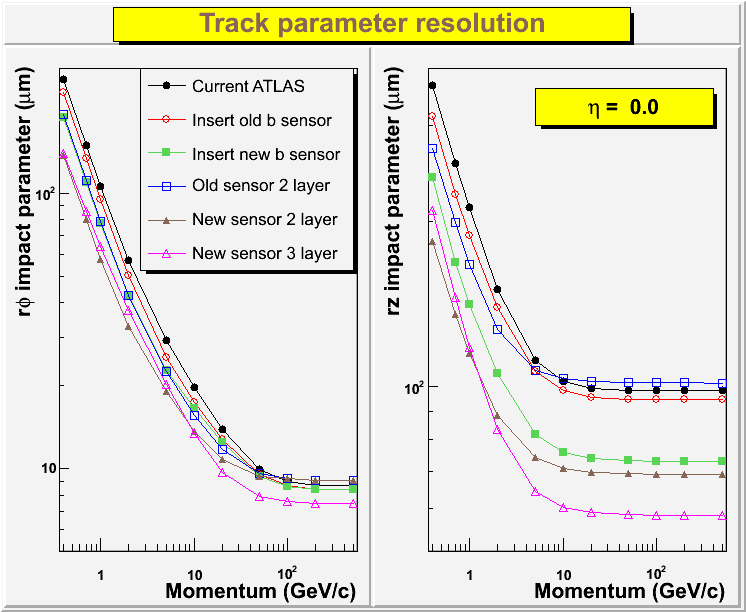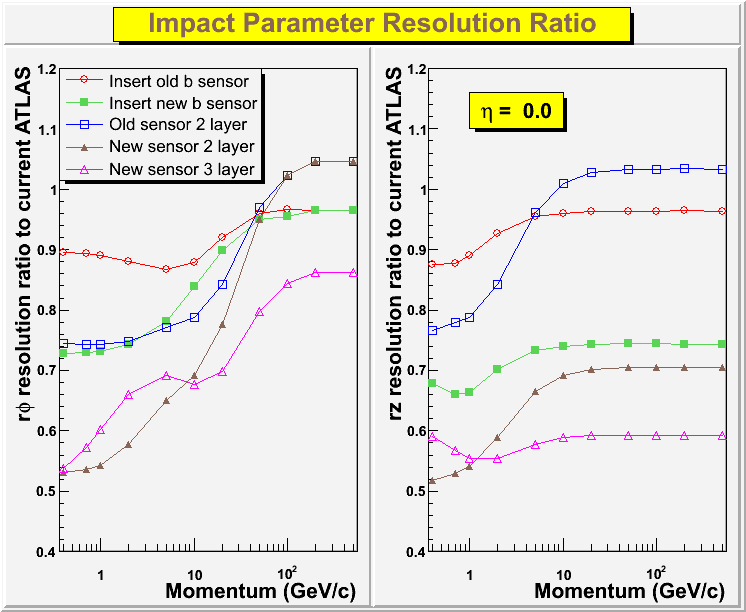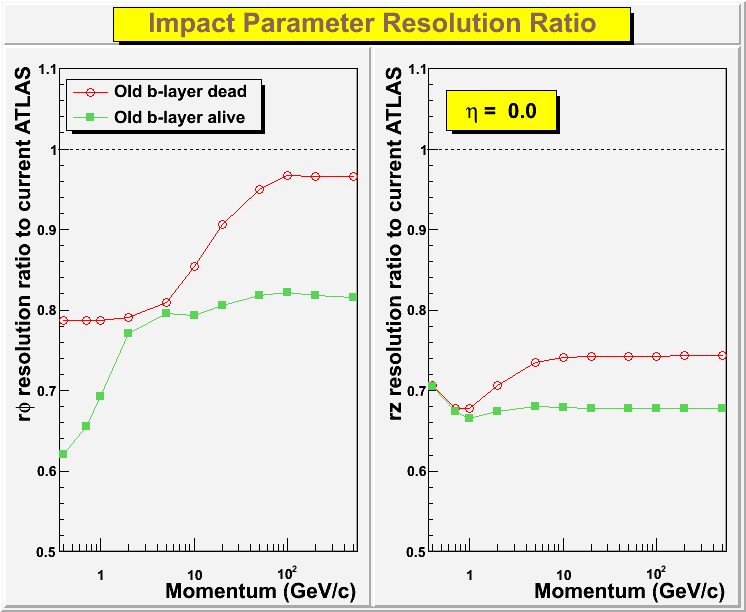
As the main goal is see the subtle differences between the different B-layer replacement geometries, the study was done using a standalone track error calculation. The software used is the LCDTRK package extended and maintained by Bruce Schumm from the original TRKERR package from Walt Innes. Track covariant error matrix is constructed from the specified detector geometry, material and hit resolution tp extrapolate the track parameter resolution at the interaction point.
Since the B-layer replacement is primarily an issue in the barrel, this initial study is for barrel only. The invariant detector description for beampipe, SCT and TRT are summarized below:
| Detector Part | Description | Mean Radius (cm) | Orientation angle | Radiation length(%) | Spatial resolution (microns) |
| Beam pipe | 800mm Be 800mm Be |
2.94 3.42 |
0 |
0.227 0.227 |
- |
| Pixel support tube | Pixel outer carbon-fiber support tube | 22.9 |
0 |
1.50 | - |
| SCT Barrel 0 | Si Strip pair | 29.9 | 0, +40mrad | 2.96 | 17 |
| SCT Barrel 1 | Si Strip pair | 37.1 | 0, - 40mrad | 2.96 | 17 |
| SCT Barrel 2 | Si Strip pair | 44.3 | 0, +40mrad | 2.96 | 17 |
| SCT Barrel 3 | Si Strip pair | 51.4 | 0, - 40mrad | 2.96 | 17 |
| TRT layers | 36 Straw tube layers | 57.6-107.5 |
0 |
36*0.40 | 130 |
Note: Beam pipe description is based on current geometry DB used for simulation, but the real beampipe according to ATLAS detector JINST paper only has one 800mm Be shell, but wrapped by heater, kapton, aerogel insulation and aluminum foil, so that my own estimate of the actual radiation length is ~0.73%. An upgrade system might be able to reduce the beam pipe material, but in order to concentrate on the relative merits of the different pixel configurations, the beam pipe is kept the same throughout as in the current simulation.
For the pixel configurations, the variations also considered the possibility for a "new sensor" with lighter support/cooling arrangements to effectively halve the material per layer, and a 250mm pixel length.
Old sensor: 50mmx400mm
pixels; 10mm rf
resolution, 115mm z resolution; 3.1% radiation length
including cooling/support/cables.
New sensor: 50mmx250mm
pixels; 10mm rf
resolution, 72mm z resolution; 1.5%
radiation length including cooling/support/cables.
The pixel geometry options, together with the impact parameter resolution results for h=0:
| Geometry | Sensor type | Mean Raidus (cm) |
Impact parameter resolution (mm) at h=0 (rf, rz) | ||
| PT=1 GeV/c | PT=10 GeV/c | PT=100 GeV/c | |||
| Current ATLAS | L0 Old L1 Old L2 Old |
5.05 8.85 12.25 |
106, 212 | 19.8, 102 | 9.0, 98 |
| Insert old b sensor | L0' Old L0 Old (dead) L1 Old L2 Old |
3.70 5.05 8.85 12.25 |
95, 189 | 17.4, 98 | 8.7, 95 |
| Insert new b sensor | L0' New L0 Old (dead) L1 Old L2 Old |
3.70 5.05 8.85 12.25 |
78, 141 | 16.6, 76 | 8.6, 73 |
| Old sensor 2 layer | L0 Old L1 Old |
3.70 8.85 |
79, 167 | 15.6, 103 | 9.2, 102 |
| New sensor 2 layer | L0 New L1 New |
3.70 8.85 |
58, 115 | 13.7, 71 | 9.2, 69 |
| New sensor 3 layer | L0 New L1 New L2 New |
3.70 5.05 8.85 |
64, 118 | 13.4, 60 | 7.6, 58 |


Revisiting the effect of current B-layer (Sep/08)
It is most likely that by the time the new B-layer insertion is installed, the old B-layer will still be alive for sometime. Is then the new B-layer insertion somewhat of a waste other than some extra material added ? Once we have the new B-layer, would it be better to steal the old B-layer's services to make the job easier since the old B-layer may be just dead material anyway ? A specific comparison is made to answer these questions to compare the new B-layer insertion (with a more realistic material budget of 2% r.l.) with the old B-layer completely dead or still functional:

The conclusion is quite clear: we should keep the old B-layer running as long as we could. It's not just dead material and still brings some significant resolution gain to the table. The new B-layer insertion should plan for extra service path all the way and not steal the existing services from current B-layer.
Last update: Mon Apr 14 18:58:36 PDT 2008